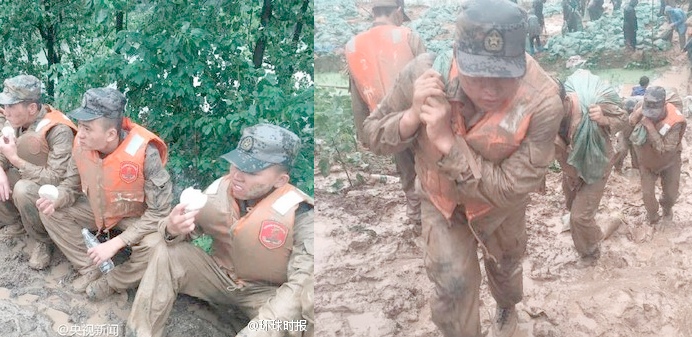Nearly two hundred people have been killed and 1.5 million displaced in recent weeks as a result of floods across central and southern China. Government corruption and overdevelopment have been blamed for exacerbating the damage, but Global Voices’ Oiwan Lam writes that domestic reporting has focused almost exclusively on positive coverage of the official response and disaster relief, with censors cracking down on critical social media posts.
Banned news outlets outside China reported that the floods in Anhui have killed a few dozen people. Hundreds of flood victims demonstrated on July 8 against state-owned Chinese Central Television’s (CCTV) interview with local disaster relief officials who claimed that the floods only affected two major streets.
Of course, news about the protest could not be found on Weibo. What did circulate widely was news about the People’s Liberation Army’s heroic and self-sacrificing contribution in disaster relief work: […]
Many netizens were not touched by the propaganda. Below is a sample of the skepticism found in the comment threads:
Whenever I read these kinds of accounts, I feel doubt. The official propaganda turns the fact about lack of disaster relief equipment and coordination work into a “touching” story. Such an act is using the frontline soldiers’ sweat and blood [for political purposes]. Every time they frame the disaster as the most serious one in 100 years, every time they use the disaster to pull at China’s heartstrings. The propaganda is good at turning a disaster into a positive story and making human errors invisible. […] [Source]
Flood coverage featured prominently in a recent survey by China Media Project’s David Bandurski of news stories in The Paper, a slick government-funded media site launched in 2014 in response to President Xi Jinping’s call to build influential “new-type media groups.”
So I brewed myself a pot of coffee and gave The Paper roughly five cups to sell me on its substance. In that time, I was able to read 46 articles in the current affairs section — where I expected to find the most potent stuff — taking each article as it appeared on the website version. Here are my notes, indicating the source of the material (other media or exclusive?), general topic and reporting.
*On flood response in Anhui province — SOURCE: compilation of official government Weibo releases, quoting head of response team, with images of troop mobilisation and cheering crowds.
[…] *On the removal of villagers from the flood zone, very pretty positive story on governemnt response — SOURCE: China Central Television.
[…] *Li Keqiang goes to flood disaster front lines, SOURCE China’s government website
[…] *Infographic on flooding and number of people in various regions affected, no additional context or reporting — SOURCE: The Paper.
[…] *On a man whose pigs were purchased by a company after news of their plight in serious flooding became national news — SOURCE: The Paper.
[…] *Special timeline and photo slideshow of flooding across China — SOURCES all official. [Source]
See more at The Telegraph on the temporary rescue of 6,000 pigs which can now be slaughtered and eaten instead of drowning. In another popular feel-good story, the People’s Daily reported on the wedding of a young Henan couple who did not let the floods postpone their marriage ceremony.
Reports on top leaders’ visits to disaster zones—however belated—are a traditional staple of coverage. Lower-level officials keen to follow this example have been accused of staging photo opportunities, while others have faced mockery for their florid praise.
In previous years, Chinese authorities have issued censorship instructions ordering media outlets to focus on “positive reporting” of floods and to remove critical reports on collapsed infrastructure and mass petitioning in the aftermath of the disasters.








